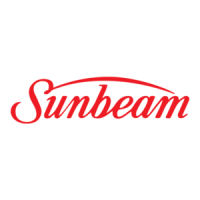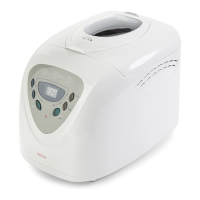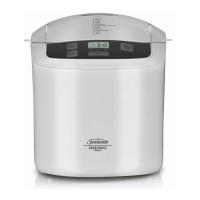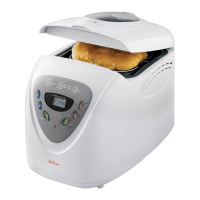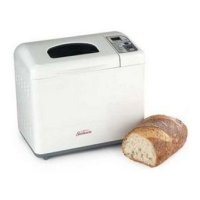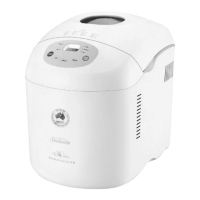Do you have a question about the Sunbeam SmartBake BM7850 and is the answer not in the manual?
Key safety instructions for using the Sunbeam bread maker and electrical appliances.
Instructions for preparing the breadmaker before operation.
Guidelines for safe operation of the breadmaker during use.
Recommendations for the optimal placement and environment for the breadmaker.
Steps for safely turning off and cleaning the breadmaker.
Specific safety warnings regarding attachments, usage, and damage.
Dispenser that automatically adds ingredients during kneading.
Window allowing observation of the breadmaking process.
The pan designed for baking bread, featuring a non-stick surface.
How to select breadmaking menus from 1 to 12 using the MENU button.
How to select the loaf size (750g, 1.0kg, 1.25kg).
How to choose the desired crust colour (Light, Medium, Dark).
How to cycle through and use saved favourite recipes.
Allows creation or customisation of breadmaking programs.
Saves customised menus for later use.
Sets a delayed start for breadmaking up to 15 hours.
Instantly cancels programming or the breadmaking process.
Starts, pauses, or resumes the breadmaking cycle.
Warms ingredients before the first kneading stage.
Mixes ingredients, activates yeast, and forms dough structure.
Allows dough to expand and produce gas.
The final stage where the bread is cooked at higher temperatures.
Keeps bread warm for up to 60 minutes after baking.
For traditional white bread, with options for loaf size and crust colour.
Decreases overall completion time for faster bread making.
Designed for gluten-free recipes, also suitable for yeast-free breads.
For recipes with whole wheat, rye, oats, or bran, includes a preheat cycle.
For breads with additional sugar, fruit, or chocolate, with reduced baking temperature.
For lighter texture breads with crispier crusts.
For making a variety of sweet and savoury homemade cakes.
For rapid bread making in approximately 80 minutes.
For making fresh savoury and sweet jams.
For immediate baking or adding extra baking time.
For making pasta dough for fresh pasta.
For creating doughs for breads, croissants, bread rolls and pizza.
Instructions on adding ingredients into the bread pan in the correct order.
How to correctly insert and secure the bread pan into the machine.
Instructions for using the automatic fruit and nut dispenser.
How to navigate and select the desired breadmaking menu.
Choosing the appropriate loaf size for your recipe.
Selecting the desired crust colour for your bread.
Initiating the selected breadmaking program.
Steps for safely removing, cooling, and handling the baked bread.
Details on the automatic keep warm cycle and its duration.
Instructions for unplugging, cooling, and preparing for the next use.
Explanation of yeast's role in bread rising and proper usage.
Information on protein content, texture, and storage of different flours.
How bread improver affects gluten content, structure, and texture.
How sugars affect sweetness, crust browning, and yeast activity.
The importance of liquids in forming gluten for bread to rise.
How salt adds flavour and controls yeast action.
Role of eggs in providing liquid, assisting rise, and adding flavour.
How fats enhance flavour and retain moisture in bread.
Guidelines for using store-bought bread mixes with the breadmaker.
Tips on ingredient combinations and expected bread inconsistencies.
Details on standard metric measuring units for ingredients.
Techniques for accurately measuring dry ingredients like flour.
Proper methods for measuring liquid ingredients.
Accurate measurement of solid fats using spoons or scales.
The correct sequence for adding ingredients to the bread pan.
How the machine automatically mixes and kneads dough.
The process of dough rising and maintaining optimal temperature.
Breaking apart air pockets for a more even texture.
The second rising phase, adjusted for different bread types.
The automatic regulation of baking time and temperature.
How the machine helps prevent soggy crusts and aids cooling.
Adjusting the preheat time for yeast activation.
Customising kneading time and paddle speed.
Adjusting knockdown time and paddle speed.
Adjusting time and temperature for dough rising.
Setting the adjustable time and temperature for baking.
Setting the adjustable time for the keep warm function.
Steps to save your programmed favourite recipe.
How to modify or replace existing saved favourite recipes.
Procedure to completely delete a saved favourite recipe.
How to preview menus and favourite recipes before starting.
Instructions for setting a delayed start for breadmaking.
An example illustrating how to use the time delay function.
Tips on ingredient order, freshness, and storage.
Best practices for slicing and freezing freshly baked bread.
Techniques for applying toppings to bread before baking.
Factors influencing the browning and colour of the bread crust.
Adjustments and suggestions for baking at high altitudes.
Instructions for cleaning the breadmaker's outer surfaces.
How to wash and care for the non-stick baking pan.
Steps for safely removing and cleaning the breadmaker lid.
Recommendations for storing the breadmaker when not in use.
Advice for achieving optimum results when baking cakes.
Instructions for making jam and sterilising jars for preservation.
Instructions for preparing pasta dough using the breadmaker.
Techniques for adding toppings and glazes to dough before baking.
Step-by-step guides for shaping dough into different forms.
Instructions for shaping dough into scrolls, breadsticks, rolls, and baguettes.
Explanation of audible signals indicating machine status.
Guidance on adapting recipes and ingredient substitutions for New Zealand.
Advice on selecting and storing appropriate flours for baking.
Recommended yeast types and the role of vitamin C as an improver.
Options for substituting sugars and fats in recipes.
Information on salt, water temperature, and jam setting alternatives.
Methods for accurately measuring flour, including weighing and cup measures.
Guidelines for measuring liquids and other ingredients.
Definitions of common measurement abbreviations used in recipes.
How to assess and adjust dough consistency during kneading.
Contacting customer service for troubleshooting and further assistance.
Information on warranty service and authorised repair agents.
Key safety instructions for using the Sunbeam bread maker and electrical appliances.
Instructions for preparing the breadmaker before operation.
Guidelines for safe operation of the breadmaker during use.
Recommendations for the optimal placement and environment for the breadmaker.
Steps for safely turning off and cleaning the breadmaker.
Specific safety warnings regarding attachments, usage, and damage.
Dispenser that automatically adds ingredients during kneading.
Window allowing observation of the breadmaking process.
The pan designed for baking bread, featuring a non-stick surface.
How to select breadmaking menus from 1 to 12 using the MENU button.
How to select the loaf size (750g, 1.0kg, 1.25kg).
How to choose the desired crust colour (Light, Medium, Dark).
How to cycle through and use saved favourite recipes.
Allows creation or customisation of breadmaking programs.
Saves customised menus for later use.
Sets a delayed start for breadmaking up to 15 hours.
Instantly cancels programming or the breadmaking process.
Starts, pauses, or resumes the breadmaking cycle.
Warms ingredients before the first kneading stage.
Mixes ingredients, activates yeast, and forms dough structure.
Allows dough to expand and produce gas.
The final stage where the bread is cooked at higher temperatures.
Keeps bread warm for up to 60 minutes after baking.
For traditional white bread, with options for loaf size and crust colour.
Decreases overall completion time for faster bread making.
Designed for gluten-free recipes, also suitable for yeast-free breads.
For recipes with whole wheat, rye, oats, or bran, includes a preheat cycle.
For breads with additional sugar, fruit, or chocolate, with reduced baking temperature.
For lighter texture breads with crispier crusts.
For making a variety of sweet and savoury homemade cakes.
For rapid bread making in approximately 80 minutes.
For making fresh savoury and sweet jams.
For immediate baking or adding extra baking time.
For making pasta dough for fresh pasta.
For creating doughs for breads, croissants, bread rolls and pizza.
Instructions on adding ingredients into the bread pan in the correct order.
How to correctly insert and secure the bread pan into the machine.
Instructions for using the automatic fruit and nut dispenser.
How to navigate and select the desired breadmaking menu.
Choosing the appropriate loaf size for your recipe.
Selecting the desired crust colour for your bread.
Initiating the selected breadmaking program.
Steps for safely removing, cooling, and handling the baked bread.
Details on the automatic keep warm cycle and its duration.
Instructions for unplugging, cooling, and preparing for the next use.
Explanation of yeast's role in bread rising and proper usage.
Information on protein content, texture, and storage of different flours.
How bread improver affects gluten content, structure, and texture.
How sugars affect sweetness, crust browning, and yeast activity.
The importance of liquids in forming gluten for bread to rise.
How salt adds flavour and controls yeast action.
Role of eggs in providing liquid, assisting rise, and adding flavour.
How fats enhance flavour and retain moisture in bread.
Guidelines for using store-bought bread mixes with the breadmaker.
Tips on ingredient combinations and expected bread inconsistencies.
Details on standard metric measuring units for ingredients.
Techniques for accurately measuring dry ingredients like flour.
Proper methods for measuring liquid ingredients.
Accurate measurement of solid fats using spoons or scales.
The correct sequence for adding ingredients to the bread pan.
How the machine automatically mixes and kneads dough.
The process of dough rising and maintaining optimal temperature.
Breaking apart air pockets for a more even texture.
The second rising phase, adjusted for different bread types.
The automatic regulation of baking time and temperature.
How the machine helps prevent soggy crusts and aids cooling.
Adjusting the preheat time for yeast activation.
Customising kneading time and paddle speed.
Adjusting knockdown time and paddle speed.
Adjusting time and temperature for dough rising.
Setting the adjustable time and temperature for baking.
Setting the adjustable time for the keep warm function.
Steps to save your programmed favourite recipe.
How to modify or replace existing saved favourite recipes.
Procedure to completely delete a saved favourite recipe.
How to preview menus and favourite recipes before starting.
Instructions for setting a delayed start for breadmaking.
An example illustrating how to use the time delay function.
Tips on ingredient order, freshness, and storage.
Best practices for slicing and freezing freshly baked bread.
Techniques for applying toppings to bread before baking.
Factors influencing the browning and colour of the bread crust.
Adjustments and suggestions for baking at high altitudes.
Instructions for cleaning the breadmaker's outer surfaces.
How to wash and care for the non-stick baking pan.
Steps for safely removing and cleaning the breadmaker lid.
Recommendations for storing the breadmaker when not in use.
Advice for achieving optimum results when baking cakes.
Instructions for making jam and sterilising jars for preservation.
Instructions for preparing pasta dough using the breadmaker.
Techniques for adding toppings and glazes to dough before baking.
Step-by-step guides for shaping dough into different forms.
Instructions for shaping dough into scrolls, breadsticks, rolls, and baguettes.
Explanation of audible signals indicating machine status.
Guidance on adapting recipes and ingredient substitutions for New Zealand.
Advice on selecting and storing appropriate flours for baking.
Recommended yeast types and the role of vitamin C as an improver.
Options for substituting sugars and fats in recipes.
Information on salt, water temperature, and jam setting alternatives.
Methods for accurately measuring flour, including weighing and cup measures.
Guidelines for measuring liquids and other ingredients.
Definitions of common measurement abbreviations used in recipes.
How to assess and adjust dough consistency during kneading.
Contacting customer service for troubleshooting and further assistance.
Information on warranty service and authorised repair agents.
| Model | BM7850 |
|---|---|
| Product Type | Bread Maker |
| Capacity | 2 lb |
| Number of Preset Programs | 13 |
| Crust Color Settings | Light, Medium, Dark |
| Viewing Window | Yes |
| Power | 600 W |
| Display | LCD |
| Keep Warm Function | Yes |
| Delay Timer | Yes, 13 hours |
